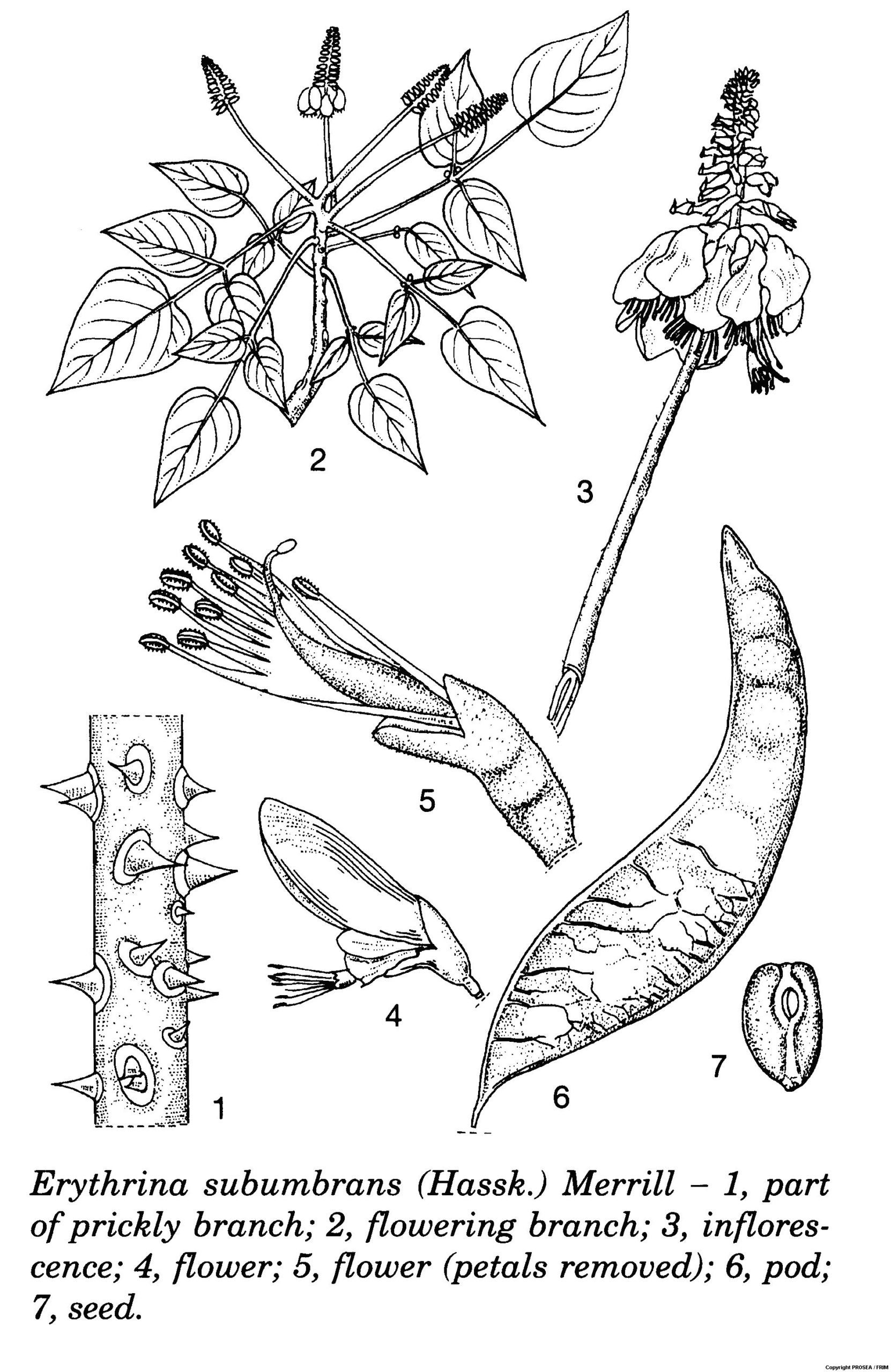Erythrina subumbrans (Hassk.) Merrill
Family
Leguminosae
Synonyms
Erythrina lithosperma Miquel, Hypaphorus subumbrans Hassk., Erythrina hypaphorus Boerl.
Vernacular Names
|
Malaysia |
Dedap batik, cengkering. |
|
English |
December tree. |
|
Thailand |
Thonglang-pa (northern), thong-Iang (central). |
|
Indonesia |
Dadap duri (general), dadap rangrang (Sundanese), dadap ri (Javanese) (armed forms); dadap minyak (general), dadap lesang (Sundanese), dadap lenga (Javanese) (thornless forms). |
|
Philippines |
Dap-dap (Tagalog), rarang (Bikol), anii (Bisaya). |
|
Myanmar |
Ye-katit. |
|
Papua New Guinea |
Th’o:ng hla:ng. |
Geographical Distributions
Erythrina subumbrans occurs naturally from India and Sri Lanka, throughout Southeast Asia (except New Guinea) to Fiji and Samoa. Now, it is distributed throughout the tropics.
Description
Erythrina subumbrans is a deciduous, medium-sized tree which can reach 5-25 m tall while its trunk can reach up to 60 cm in diameter. The crown spreads and the bark is whitish. The trunk and branches are armed with stout prickles while in cultivation, it is mostly unarmed.
The leaves are arranged alternate and with three leaflets. The stipules are orbicular, small and caducous. The rachis is 10-21 cm long and inclusive of the petiole which is 8-16 cm long and thickened at the base. The petiolule is up to 7 mm long. There are 2 stipels below the lateral leaflets. They are stipitate, cup-like, glandular and measure 2 mm long. The leaflets are ovate-triangular-rhomboid, with terminal one being largest and measuring 8-16 cm x 6-14 cm. The base is rounded or cordate, acuminate at apex and hairless.
The inflorescence is racemose at the upper leaf axils. It is 5-23 cm long and brownish-hairy. There are many flowers arranged in groups of 3. The peduncle is cylindrical, robust, measures 3-15 cm long and pubescent. The pedicel is 2-3 mm long, where in fruit it is up to 6 mm long. The sepal is bell-shaped, measures 1-1.5 cm long, splits open halfway down, hairy and yellow-green. The 5 petals are red where the upper part is broadly elliptical, shortly clawed, measuring 2.5-4 cm x 2-3 cm, scarlet and with numerous white stripes at the base inside. The wings are as long as the keel or slightly longer. They are about 1.5 cm long, and pale red with a blackish at the upper margin. There are 10 stamens which are 3-3.5 cm long, monadelphous but with vexillary stamen slightly shorter than the other ones. The pistil is with a hairy ovary.
The pod is flat, curved, measures 10-15 cm long and on a slender stalk 3-4.5 cm long. The lower part is seedless and it is 2-2.5 cm wide, while the upper part is thicker which is 1-1.5 cm wide and 1-5-seeded. It is septate between the seeds and dehiscent. The seed is ellipsoid, measuring 7-18 mm x 5-11 mm, smooth and dull black.
Ecology / Cultivation
Erythrina subumbrans occurs at low and. medium altitudes, from (0-)300-1500 m, in moist valleys, near streams, in open locations and secondary forests. It requires a high annual rainfall with a maximum of 4 months with less than 100 mm rainfall, and a mean annual temperature above 22°C. It is reported, however, to occur gregariously on the Ijen plateau in East Java, in open grasslands, in stony or sandy, occasionally dry places; elsewhere, it is widely dispersed. The trees are fairly tolerant of wind, unless branches have been damaged by borers. The seeds are dispersed by water and occasionally by birds.
Line Drawing / Photograph
References
-
Plant Resources of South-East Asia No.11: Auxiliary plants.



